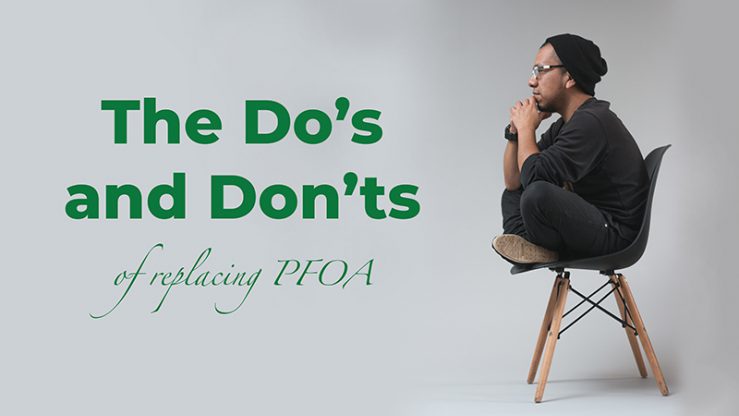The Do’s and Don’ts of replacing PFOA
A couple of months ago, we wrote about upcoming restrictions of a whole bunch of chemicals this year in the European Union. With the PFOA restriction fast approaching, we thought we’d share some do’s and don’ts about replacing this chemical.
Perfluorooctanoic acid – more commonly known as PFOA – will be restricted from July 4, 2020 in the EU. This means that from then on it will be illegal to manufacture and sell the substance and to use it in production or as an ingredient in products, including imported goods. There are a few, very specific, exemptions from the restriction that have a postponed deadline, but essentially, PFOA will be completely banned in the European Union come July.
So, if you haven’t done it already, you need to stop using PFOA and find an alternative.
Now, since PFOA belongs to a large group of chemicals called PFAS, consisting of 4,700 similar substances, it might be tempting to just switch to one of the other PFAS chemicals that hasn’t been restricted yet. But that wouldn´t solve the problem, it would only postpone and perpetuate it.
“Substituting PFOA for another PFAS chemical means that
you would have to do the same
thing all over again”
The most common way of regulating hazardous chemicals in the European Union is to regulate them one at a time, substance by substance, which unfortunately means that PFAS regulation moves at a snail’s pace at the moment. Because of this there are now talks about using a group-based approach to deal with the problem and regulate all persistent chemicals at once.
So, substituting PFOA for another PFAS chemical means that you – sooner or later – would have to do the same thing all over again. That’s one reason to why it would be a bad idea. Another reason is that it would completely circumvent the entire reason for restricting PFOA in the first place.
PFOA is known for its outstanding water-repellent and non-stick properties and has been widely used in industrial production for over 70 years, but the chemical is also known for its harmful properties and the fact that it doesn’t break down in nature. It is associated with several negative health effects such as lowered birth weights, cancer, reduced sperm quality, attention deficit disorder and negative effects on the immune system.
This is especially concerning since the substance takes forever to break down, meaning that the chemical has all the time in the world to affect our health in a harmful way. PFOA is also bio-accumulative. In other words, it builds up in tissue and accumulates up along the food chain, culminating at the top where, for example, humans are found.
“What needs to be done
is to move away from the
PFAS chemicals and find
safer alternatives”
The fact is that all PFAS chemicals are likely to share these hazardous properties, so switching to an equally harmful cousin would only perpetuate the environmental problems and health issues related to PFOA.
Instead, what needs to be done is to move away from the PFAS family of chemicals and find safer alternatives. On Marketplace there are several alternatives available with various functions for a range of different applications.
Sympatex offers a safer alternative for one of the most common applications of PFAS – waterproofed textiles. The company has produced a PFAS-free water and windproof membrane that is both climate-neutral and 100% recyclable.
Another alternative in the same application comes from the Swiss company Schoeller Textile, which has developed a PFAS-free mud and water-repellent technology that imitates the natural water-repelling protection of a duck’s plumage.
Food packaging materials are another common application for PFOA and other persistent chemicals. Rottneros Packaging from Sweden has developed a food packaging tray made from wood pulp, which is both recyclable, renewable and biodegradable.
There are a lot of safer alternatives to PFOA out there, and it’s often not a question of replacement chemicals. Instead, the solutions tend to lie in new materials or new technologies.
There is no longer any need to use harmful PFAS chemicals in products and, fortunately, many companies are starting to realise that and move away from them.






